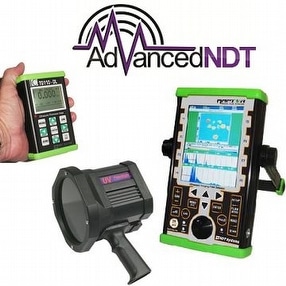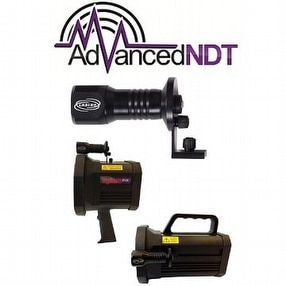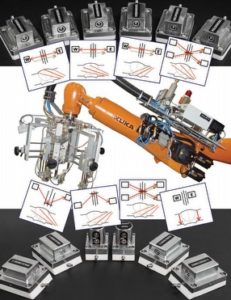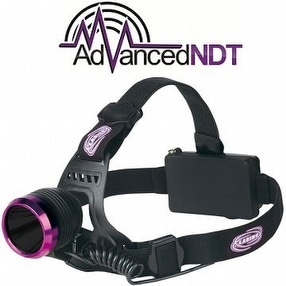Send enquiry to Advanced NDT Ltd.

Forensic Lighting (ALS) Range
SecurityForensic Lighting – ALS – Alternative Light Source Range
Product Code: Labino ALS, TrAc Finder, Nova Torch, MB Aris, SuperXenon LUMI & Labino White Lights & Torches
The TrAc Finder Crime Kit, The Nova LED Torch Lights & The New SuperXenon LUMI Kit – Forensic Alternative light sources / Alternate Light Sources (ALS) are invaluable for detecting substances (forensic trace) at a crime scene such as body fluids (semen, urine, saliva, vaginal fluids, blood, sweat etc.), bruising, hair, fibres, foot prints, fingerprints, Ninhydrine (treated fingerprints), Super glue (treated fingerprints), Lumicyano Treated Fingerprints, Fluorescent dyes, powders, stamps, markers, basic yellow 40, Cyanoacrylate, smart DNA water (SmartWater TM) and general searching.
At a crime scene, fast and accurate detection of possible traces is of vital importance. Many biological fluids are fluorescent in nature. When such traces are illuminated with light of the right wavelength they fluoresce and are detectable to the investigator. The degree to which various substances become visible when using different filters depends on the state of the substance and the surface on which the substance exists. Deciding what Light Source to use to achieve the best result in finding traces at the crime scene is an art. It takes years of experience to learn what light to use depending on the occasion – it’s not an exact science. Therefore Labino makes it possible for each user to put together their own unique ALS Kit. No crime scene looks the same. No crime scene investigator uses the same method. By working close to the police we try to build knowledge based on your experience and expertise. Everything we do is based on knowledge from the experts on the field. Our goal is to develop tools that helps the crime scene investigator and police to find traces and evidence.
Forensic light – detecting traces with UV light
At a crime scene, fast and accurate detection of possible traces is of vital importance. Many biological fluids are fluorescent in nature, when such traces are illuminated with light of the right wavelength, they fluoresce and are detectable to the investigator.
Crime scene determines choice of filter
The degree to which various substances become visible when using different filters depends on the state of the substance (trace) and the surface on which the substance exists. Both UV and blue light can be efficient, for example, when searching for traces of semen. The conditions of the crime scene often will determine which sort of light (i.e.. wavelength) will be most effective. Criminal investigators therefore choose between using UV light, blue light, green light or a general crime scene filter in combination with the right goggles, depending on their needs.
Substances detected with UV and White light
Crime – UV and blood
Crime – UV and body fluids
Crime – UV and fingerprints
Crime – UV and fire investigations
Crime – UV and invisible ink
Crime – UV and narcotics
Crime – White light and crime scene investigation
White light – shoe prints, fibres, SAR, fire Powerful intense white light enables the investigator to find evidence that otherwise might go unnoticed, such as dust impressions, shoe prints and fibres. Patterns and details can be clearly seen when using a Labino white light lamp, making it possible to take sharp clear photos. The Labino white light lamp is commonly used during search and rescue operations as well as when general lighting is needed at darkened fire scenes.
Forensic laboratory
Labino lamps provide intense illumination over a wide area, making them a popular choice among those working in forensic laboratories. Due to the high intensity and long lifetime of Labino bulbs and LED’s, Labino lamps are a cost effective alternative to other more expensive and complicated light sources.
UV & Blood DETECTING BLOOD STAINS
There are several common ways to detect blood at the crime scene. One very easy and quick way to detect blood is to use UV light.
When to use UV light to detect blood:
• Reduce the risk of collecting unnecessary stains
• Detect blood on dark, red or violet surfaces
• Find blood stains that are concealed by paint
Reduce the risk of collecting unnecessary stains
By using ultraviolet light it is possible to do an effective and quick check for possible bloodstains. A bloodstain exposed to UV light absorbs all light of that bandwidth and does not reflect back – that is to say, it does not fluoresce in any way. Thus the stain will appear black under UV. Although not a conclusive test for blood, it is an effective presumptive test and can often eliminate the unnecessary collection of stains that appear to be blood are actually from another source.
Dark surfaces
The UV light source is also effective for providing sufficient contrast of bloodstains that are found on red- or violet-coloured objects. Such stains often fade into the background so well that it is impossible to photograph them. Ultraviolet light often provides sufficient contrast between the background and stain to allow the stains to be visualized in a photograph.
Blood concealed by paint
It is not uncommon that a perpetrator of a crime tries to get rid of potentially incriminating evidence. This may include painting over areas that have been exposed to blood. To the naked human eye it is next to impossible to see that a blood stain has been painted over. By using ultraviolet light however, it is possible to detect blood stains that have been concealed by paint.
UV & Body Fluids SEMEN | URINE | SWEAT | SALIVA
Detecting body fluids at the crime scene is a delegate task. Using a UV light lamp however makes the job easier.
When to use UV light to detect body fluids:
Mark up the crime scene
Most stains from body fluids can be seen when using a high intensity UV light. That is to say that most body fluids have some fluorescent nature or reveal themselves in a special way when illuminated with UV light. In most cases it is not possible to see such stains otherwise. The most effective way of using the UV lamp is to use it to ‘mark’ the crime scene. In other words, you mark all stains that could be useful ‘traces’. When using an intense UV light it is also possible to see things at a distance that otherwise would be nearly impossible to see. While the UV light cannot confirm exactly what sort of stain you are looking at, it does indicate where the stains or body fluids are. This makes it possible to then take samples or perform further investigation, or using an ALS kit to identify further.
Dark textiles
The high intensity UV light is a superb complement to more advanced Alternative Light Sources due to the fact that ALS’s often have limitations in finding body fluids on very dark textiles. High intensity UV light is being used for example to examine the interior of black coloured ‘robber’ masks, and to illuminate the sweat seen on the inside of these.
What body fluids are fluorescent by nature?
• Semen (DNA)
• Vaginal secretion (DNA)
• Urine (DNA if it contains blood or other body fluid)
• Sweat (DNA)
• Saliva (DNA)
Semen Semen is very fluorescent by nature and the fluorescence can be observed on dark as well as light textiles when illuminated with an intense UV light, without the need for using coloured goggles.
Vaginal secretion Vaginal fluid is very hard to detect at all times, as it has a very weak fluorescence.
UV & Fingerprints COLLECTING FINGERPRINTS
There are several methods of gathering fingerprints, and fluorescent powder is used for some of them. Such powder is used in combination with ultraviolet light and can be used on both non-porous smooth and rough surfaces. We have also introduced the ground breaking SuperXenon LUMI kit which is a specifically designed UV light and Lumicyano liquid making it ideal for finger print recognition.
Non-porous smooth surfaces:
• Painted or varnished surfaces
• Glass or Plexiglass
• Most plastics
Non-porous rough surfaces:
• Vinyl
• Leather
• Textured counter tops
• Textured surfaces
Use fluorescent powder and UV light when:
• The surface is dark, patterned or speckled
• The fingerprint is very weak
• The surface is not to be damaged by carbon
• The possible DNA on the stain is not to be damaged by carbon or other powders
Dark, patterned or speckled surfaces Putting dark powder on a dark patterned or speckled surface makes it very hard to see the fingerprint. By developing the print with fluorescent powder and a brush, and illuminating it with UV, the fingerprint glows and is easy to photograph. This method is very successful on beer cans for example.
Weak fingerprints Fluorescent powder is very ‘delicate’ compared to common powders used for fingerprints. It is therefore very useful when trying to detect weak prints. If you develop the print with a very small amount of fluorescent powder (and brush) and illuminate it with a UV light, the fingerprint will glow and become therefore easy to photograph.
Avoid damaging surface with carbon If you are going to develop a fingerprint on a surface that you do not want to damage with carbon – i.e. a computer made of light plastic – fluorescent powder is highly recommended. Use fluorescent powder and a brush, and illuminate the print with UV. You need only use a very small amount of fluorescent powder to achieve results, which makes it useful on areas you can’t clean, like the inside of a computer for example.
Avoid damaging fingerprints with carbon Carbon eliminates the possibility of conducting a DNA test on a fingerprint because it destroys the DNA. There might be a slight possibility that there is sweat for example on the fingerprint. If that is the case, then a UV lamp should be used first, without powder, to illuminate the sweat on the print and indicate where a DNA sample can be taken. When possible DNA has been collected from the print, the fingerprint itself can be developed with the use of powder, and it can then be photographed.
UV & Fire Investigation How is UV light used in arson investigations?
Arson investigators use ultraviolet light as a simple, reliable and cost effective method of arson detection. Ultraviolet light is used to detect information that is otherwise invisible to the human eye and to uncover valuable information which can be used to solve a fire investigation.
UV light is used to:
• Identify the presence of accelerants
• Identify pour patterns
Accelerants UV light not only assists in identifying the presence of accelerants (a substance that accelerates the spread of fire or makes a fire more intense ), but also in rapidly locating accelerant residues, and assisting in locating the point of origin of the fire. The colour which accelerants glow is affected by heat exposure. The longer an accelerant is exposed to heat (i.e. the origin), the more differentiated its fluorescence colour will be from other less exposed areas. Evidence of accelerants gets absorbed in a fire and is therefore almost always invisible to the naked eye. The area tarnished by accelerants however is easily discernible under UV light.
Hydrocarbons
Volatile hydrocarbons such as gasoline, kerosene and other petroleum fractions such as benzene, acetone, grease, lard, vegetable oils, paints, etc. fluoresce when exposed to UV light. By using UV light, investigators can accurately identify locations where samples should be collected for further laboratory analysis. UV light can also be helpful in locating fragments of incendiary devices since explosive wrappings are frequently fluorescent. Samples collected in cans and plastic evidence bags can be heated in warm water to form condensation. The latent accelerant residue rises to the surface and this can be seen under UV light.
Pour patterns UV light has been used to identify pour patterns, the shape of an accelerant container and pour trails leading back to containers. UV light will indicate accelerant long after its odour is discernible. Masking an accelerant will not prevent its UV detection. Accelerant on skin or clothing will fluoresce as well.
Advantages of UV light compared to canine or mechanical ‘sniffers’
• Use of UV light is not affected by wind conditions.
• The ‘sniffer’ indicates a general area of saturation yet does not detect specific infected areas. This makes pour pattern sampling difficult. UV light detects specific areas.
• The ‘sniffer’ is effective only two to three days after saturation. UV lamps have been proven to effectively fluoresce samples up to two months after an incident.
• After a lengthy hot fire, the odours of accelerants have usually disappeared.
ENVIRONMENTAL INVESTIGATIONS Illegal dumping UV light can assist in environmental investigations by indicating the presence of hydrocarbons on land and in water. Illegal dumping has been traced using this technique. Trace dyes can be used along with UV light, and some radioactive substances fluoresce as well.
UV & Invisible Inks PROPERTY MARKING AS A CRIME COUNTERMEASURE Police routinely use UV light to detect, identify and return stolen property that has been marked with fluorescent ink. By using a UV fluorescent marking pen, valuables can be discretely marked with important details such as a name, initials, phone number, case number, date or other information. Police also mark weapons, plastic baggies of narcotics or electronics used in sting operations using this method. Such ink is invisible to the naked eye and is only revealed when illuminated with UV light . In case of burglary, the owner of a recovered, stolen item which has been marked in this way can be traced simply by using an ultraviolet lamp. Other inks work in a near opposite way by absorbing ultraviolet light. When they are used on fluorescent paper, the written- on areas fluoresce less than the surrounding paper areas when under an ultraviolet lamp. Invisible ink pens can be used on most glass, plastic, wood, paper, cloth, and metal surfaces. By illuminating the marked surface with UV light, the marks become clearly visible to police, detectives and pawn shop owners. Also used for the detection of DNA Based Tracer Liquids such as SmartWater TM.
INTERCEPTION OF SECRET MESSAGES
Successful use of invisible ink depends on not arousing suspicion. Tell tale signs of invisible ink, such as scratches from a sharp pen, roughness or changed reflectivity of the paper can be obvious to a careful observer who simply makes use of strong light, a magnifying glass and their nose. Also, key words in the visible letter, such as 'red cabbage' or 'heat', in an odd context may alert a censor to the use of invisible ink. By using ultraviolet light, messages can be quickly screened for invisible ink and also read without first permanently developing the invisible ink. Thus, if a censor uses this method to intercept messages, he may then let the letter be sent to the intended recipient who will be unaware that the secret message has already been intercepted by a third party. A "screening station" could theoretically involve visual and olfactory inspection, an examination under ultraviolet light and then the heating of all objects in an oven before finally trying exposure to iodine fumes.
UV & Narcotics COCAINE | AMPHETAMINE | ECSTACY Some narcotics such as amphetamine, cocaine and certain MDMA tablets are clearly fluorescent when illuminated with UV light. Even minute amounts of certain narcotics can be readily visible when illuminated with UV, making the investigators work much easier when, for example, performing a house search for suspected narcotics. Powder and powder residue which remains on clothing, hands, tables, kitchen sinks, balances and other tools, and which is not normally visible in normal light, becomes highly visible with the use of ultraviolet light.
Fluorescent narcotics
• Cocaine
• Amphetamine
• MDMA tablets (including some but not all Ecstasy tablets)
Cocaine Cocaine having a purity of at least 87 % fluoresces clearly when illuminated with UV light.
Amphetamine
Some amphetamine having a purity of 78 % (i.e. of Dutch, Baltic or Polish origin) are clearly fluorescent when illuminated with UV light. Even small amounts of amphetamine are easy detectable because of their fluorescent nature.
MDMA tablets Some MDMA tablets (i.e. Ecstasy with four-leaf clover logotypes) are clearly fluorescent with UV. Even small fragments are easily visible as they fluoresce intensively.
Labino TrAc Finder Crime Kit Very High Performance MPXL Alternative Light Source / Alternate Light Source (ALS) – For Forensic & Crime Applications. An intensely powerful ALS lamp with a wide light beam and interchangeable filters. The TrAc Finder is made up of a crime kit plus a portable UV lamp from the Labino “TrAc” series (lamp sold separately yet delivered together in case and with clear protection filter already mounted).
Labino Nova Torch Crime Kit High Performance LED Alternative Light Source / Alternate Light Source (ALS) – For Forensic & Crime Applications. Labino has developed a new ALS Crime kit, the "Labino Nova Torch", based on our present torch – Labino Torch light UVG2. The kit includes 8 Led torches in different wavelengths as well as suitable accessories. The Lamp has a perfect light beam, is light weight and easy to use. The Labino Nova Torch is a cordless battery operated torch light based on the latest LED technology. The new Labino Nova Torch Light range consists of eight (8) high intensity forensic alternate light sources (ALS) for crime scene investigation as well as laboratory use.
Labino MB Aris Kit. The Labino MB Aris is an extremely portable and robust hand-held ALS Lamp based on the very popular MB Series of UV LED Lights. Ideal for Forensic Investigation and Crime scene applications.
Labino SuperXenon LUMI Kit High Performance 325nm UV Light combined with Lumicyano a Ground breaking Latent Fingerprint Solution – For Forensic & Crime Applications.
A Labino SuperXenon LUMI Kit plus Lumicyano TM Solution, in combination with a fuming chamber, provides you with everything you need to start using Lumicyano TM for fingerprint detection. It removes the post processing stage of staining or dusting with powder. Furthermore, it’s compatible with future DNA analysis.
Labino High Intensity White Lights & Torches The Labino White lamps have a unique white luminance, which makes it possible to see things that have not been possible before.
The Labino MPXL White Lights are available in three important distinctions – floodlight, midlight or spotlight, each giving different beams and intensities. The spotlight has the greatest focus and is the most intense, the floodlight has the widest beam but the lower intensity. The midlight is in between the two on both intensity and coverage. The Labino White Light Lamps & LED Torches can be switched on and off whenever used, without pre-cooling. You can use the lamp outdoors, even in the rain, as the lamps are IP65 certified. New LED Torches and Head Lamps offer even more portability and ease of access.
Note: Advanced NDT Limited Highly Recommend the use of UV Protection when working with UV Light.
Contact Advanced NDT Limited for further information & current pricing.
Click here for more information on Forensic Lighting – ALS – Alternative Light Source Range
Crime, Lighting, Lights, forensic, labino Product code: Forensic Lighting - ALS
Advanced NDT Ltd.
More products from Advanced NDT Ltd.

NDT Products & Equipment & Pages

Labino En-Liten White Light add on

ISonic AUT 16/32 Multi Channel Flaw Detector

